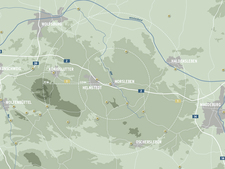Monitoring of the direct vicinity of the repository
Environmental monitoring, also referred to as immission monitoring, controls the radioactivity in the direct vicinity of the repository. Air, water, soil and plants are examined to recognise early long-term changes as a result of the discharge of radioactive materials from the repository and to control compliance with dose limits. The proper procedures for this are laid down in the statutes of the Directive for the Emission and Immission Monitoring of Nuclear Facilities (REI).
The results from environmental monitoring prove that there are no indications that the operation of the Morsleben repository increases the existing natural or civilizational radiation exposure.
Examination of water
Water samples are taken on a daily basis from the "Salzbach" at the Bartensleben mine, from a receiving water of the river Aller and at three measuring points downstream. Composite samples are made from these samples which are analysed every week to once a quarter. Furthermore, precipitation is collected and controlled for potential radioactive contamination. This is done at two immission measuring points and at a reference measuring point near Alleringersleben.
Examination of air
The air is examined for potential radioactive contamination using three different methods. Firstly, the so-called aerosol activity is measured, secondly the gamma radiation. These results are supplemented by the nationwide measurement of the gamma dose rate (ODL).
Measurement of aerosol activity
Radionuclides in the air are mainly bound to particles, so-called aerosols. To measure the aerosol activity, filters are used at two immission measuring points and at a reference measuring point near Alleringersleben for max. 14 days. These are analysed as composite sample on a monthly to quarterly basis. The immission measuring points are located where, according to calculations, the highest exposures may occur by inhaling radionuclides.

![]() Positions of the different measuring devices (in German only)
Positions of the different measuring devices (in German only)
Measurement of gamma radiation
The local dose rate caused by gamma radiation is measured at altogether 64 measuring points at a distance of up to one kilometre from the Bartensleben and Marie mines. The local (gamma) dose rate describes the external radiation dose to humans at a certain location. So-called thermoluminescence dosimeters (TLD) are used for this. The results are compared with the environmental radiation that is typical of the region and with the values of the reference measuring point near Alleringersleben.
Measurement of the gamma dose rate

![]() Positions of the measuring probes (yellow) near Morsleben
Positions of the measuring probes (yellow) near Morsleben
The region around the Morsleben repository is integrated in the Integrated Measuring and Information System for the Surveillance of Environmental Radioactivity (IMIS) of the Federal Office for Radiation Protection (BfS). The IMIS is operated on the basis of The Precautionary Radiation Act and is not part of the Directive on the Emission and Immission Monitoring of Nuclear Facilities (REI). With the help of about 1,800 measuring probes the so-called local (gamma) dose rate is measured nation-wide. The local (gamma) dose rate describes the level of the external radiation dose to humans in a certain period of time. The values can be accessed online.
Examination of soil and plants
Twice a year, soil and plant samples are taken and analysed at two immission measuring points and at one reference measuring point near Alleringersleben to control the risk of a possible intake of radionuclides via food. Based on calculations, the immission measuring points were established at locations where the highest exposure may occur through the intake of food.
Apart from the naturally occurring radionuclides, radioactive strontium and caesium were detected in the analyses. However, their concentration corresponds with the usual concentration in Northern Germany and is mainly due to nuclear weapons tests carried out at the surface and the Chernobyl reactor accident.
Independent control of results
On behalf of the Repository Surveillance Unit (EÜ), the Federal Office for the Environment of Saxony-Anhalt (LAU) as autonomous measuring institution carries out an independent, controlling and supplementing measuring programme. The results are properly examined by the Repository Surveillance unit, compared with the results of the Federal Office for Radiation Protection (BfS) and forwarded to the Federal Environment Ministry.
State of 2016.07.22

